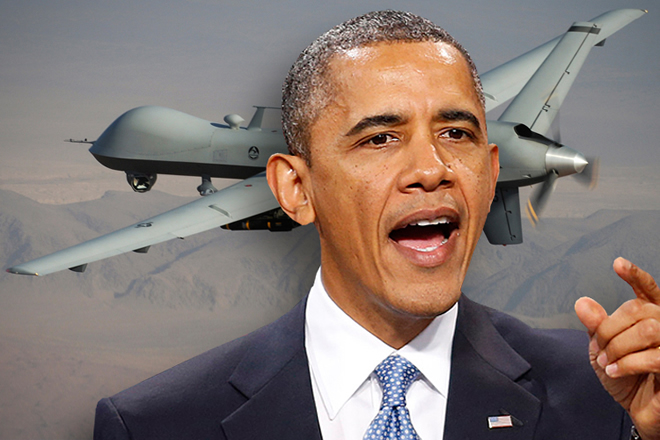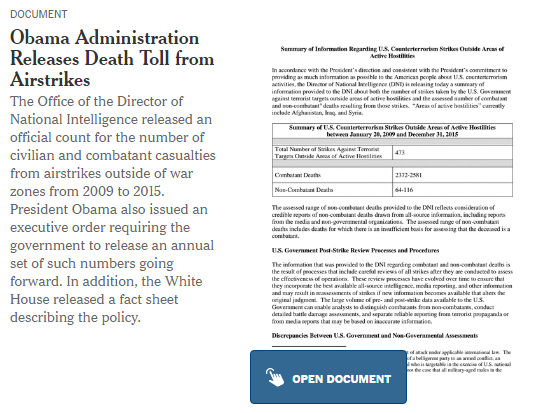
Sunday, July 3, 2016
By CHARLIE SAVAGE and SCOTT SHANE

WASHINGTON — Partially lifting the secrecy that has cloaked one of the United States’ most contentious tactics for fighting terrorists, the Obama administration on Friday said that it believed that airstrikes it has conducted outside conventional war zones like Afghanistan have killed 64 to 116 civilian bystanders and about 2,500 members of terrorist groups.
The official civilian death count is far lower than estimates compiled by independent organizations that try to track what the government calls targeted killings, and human rights groups expressed doubts about the reliability of the government’s numbers. Most of the strikes have been carried out by drones in chaotic places like Libya, tribal Pakistan, Somalia and Yemen, though a small number have involved traditional aircraft or cruise missiles.
At the same time, President Obama issued an executive order making civilian protection a priority and requiring the government in the future to disclose the number of civilian deaths each year. The order, which could be canceled or altered by a future president, tries to commit his successors to greater openness than he has achieved in his first seven years in office.
For Mr. Obama, the drone program is personal, a defining feature of his presidency. As he expanded the use of drones far beyond what President George W. Bush had begun, he took a direct role in approving some strikes, including the deliberate killing of an American, and in setting up rules to govern them.
In a seeming acknowledgment that the long-anticipated disclosure would be greeted with skepticism by critics of the drone program, the administration issued the numbers on a Friday afternoon before a holiday weekend. The use of a range of estimated civilian deaths underscored the fact that the government often does not know for sure the affiliations of those killed.
“They’re guessing, too,” said Bill Roggio, editor of the Long War Journal at the Foundation for the Defense of Democracies, who has tracked civilian deaths for more than a decade. “Theirs may be a little more educated than my guesses. But they cannot be completely accurate.”
The disclosure about civilian deaths and the executive order, the subject of months of bureaucratic deliberations, carried broader significance. Issued about seven months before Mr. Obama leaves office, the order further institutionalized and normalized airstrikes outside conventional war zones as a routine part of 21st-century national security policy.
The order declares that “civilian casualties are a tragic and at times unavoidable consequence of the use of force in situations of armed conflict or in the exercise of a state’s inherent right of self-defense,” and lays out the “best practices” necessary to reduce their likelihood and “take appropriate steps” when they occur.
The estimated number of civilian deaths between Mr. Obama’s inauguration in 2009 and the end of 2015 was contained in a report issued by the Office of the Director of National Intelligence. It said the numbers came from 473 strikes, which also killed 2,372 to 2,581 “combatants.”

The report named Afghanistan, Iraq and Syria as “areas of active hostilities” excluded from the policy. A senior administration official said tribal Pakistan — which the government treats as an extension of the Afghan battlefield in certain contexts — is not such an area; casualties there are part of the official civilian death toll.
It is an open secret that the majority of drone strikes have taken place there as Central Intelligence Agency covert operations, which has meant that the administration’s periodic pledges to be more transparent about targeted killings have not been completely fulfilled.
The executive order also said that the annual reports from the Office of the Director of National Intelligence should address any discrepancy between the official body count and what outside groups estimate. That gap is striking.
The administration’s count of civilian deaths is about half of the lowest estimate from independent watchdogs, which base their estimates largely on press reports and information from local officials. Mr. Roggio’s Long War Journal, the Washington-based security policy organization New America and the London-based Bureau of Investigative Journalism estimate that 200 to 800 civilians have been killed by American airstrikes outside war zones since 2009.
Human rights advocates and independent analysts, while welcoming the step toward transparency, expressed disappointment with the limited data.
“The government should be releasing information about every strike — the date of the strike, the location, the numbers of casualties, and the civilian or combatant status of those casualties,” said Jameel Jaffer of the American Civil Liberties Union. Without the locations and dates of strikes, he said, the administration’s numbers are impossible to compare with independent accounts.
Federico Borello, executive director of the Center for Civilians in Conflict, praised the emphasis on avoiding civilian deaths, but said the numbers released “don’t add up.”
Naureen Shah of Amnesty International said the limited disclosure should be “not the end of the public conversation on U.S. drone strikes, but just the beginning.”
The government report acknowledged that outside groups had published “significantly higher figures,” but said their numbers relied on reports about events in remote and inaccessible areas that might be inaccurate or tainted by “terrorist propaganda.”
The government, it maintained, has access to superior information when counting civilian deaths, drawing on “video observations, human sources and assets, signals intelligence, geospatial intelligence, accounts from local officials on the ground, and open source reporting” to determine whether people killed in its strikes had “undertaken certain acts that reliably connote meaningful integration” into an enemy group.
The administration also declined to break down its retroactive estimate of civilian death by year, a decision that permits it to avoid fights about how it addressed several well-known American airstrikes that generated accusations of dozens of civilian deaths — including one in Yemen in December 2009 and another in Pakistan in March 2011 that together would seem to surpass the low end of its range.
“The U.S. government may have reliable information that certain individuals are combatants, but are being counted as noncombatants by nongovernmental organizations,” the report said, cryptically.
Lumping all seven years together also makes it harder to analyze, for example, how trends may have changed since May 2013. That is when Mr. Obama issued a “presidential policy guidance” limiting airstrikes away from war zones to targets that present a “continuing, imminent threat to U.S. persons” and cases where there was a “near certainty” of avoiding civilian casualties.
While there have been credible reports of some strikes involving civilian casualties since then, the overall pace of airstrikes appears to have dropped significantly.
A senior administration official, speaking on the condition of anonymity to discuss the order, said Mr. Obama pushed for the new policy as a coda to the May 2013 guidance. Both were motivated by his desire to drain the suspicion surrounding drone strikes in order to bolster public support, at home and abroad, for a tool he believes will continue to be necessary, the official said.
Targeted killings away from battlefields — a practice denounced by some critics as assassinations — have grown as the United States has waged an open-ended war against a splintering, morphing terrorist adversary whose members flow into ungoverned regions where no ground forces are engaged in combat, and as the rise of drone technology has lowered the barriers to carrying out strikes in inaccessible places.
The report also pushed back against the claim, first reported in 2012 in The New York Times, that the government, when counting civilian casualties, presumes that any military-aged male killed in a strike zone is a combatant. It said a dead person from such a strike about whom nothing was known was presumed to be a noncombatant.
The order also generally required agencies that carry out such strikes to acknowledge United States government responsibility for civilian deaths and offer condolence payments.
To date, the United States has publicly acknowledged responsibility for only two civilian deaths — the accidental killing in 2015 of two aid workers in Pakistan who were being held hostage inside a compound of Al Qaeda when it was struck. In 2013, the administration acknowledged killing the 16-year-old son of Anwar al-Awlaki, the American cleric who had joined Al Qaeda in Yemen and himself been killed in a drone strike, but did not explicitly acknowledge that he was a civilian. An administration official said such acknowledgments and payments were rarely public.